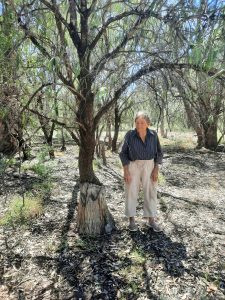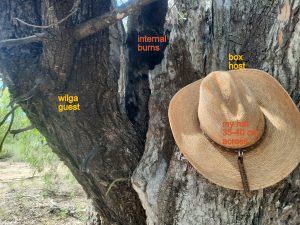Ive been running some google searches on mistletoe lately to identify an interesting variety on a Myall tree not far away. Apparently, mistletoe doesn’t kill trees unless they are already doing poorly. Here are 3 excellent sources of info – Mistletoe Breaking the myths (nsw.gov.au) https://www.abc.net.au/everyday/the-misunderstood-magical-mistletoes-of-australia/11505510?utm_campaign=abc_everyday&utm_content=link&utm_medium=content_shared&utm_source=abc_everyday
Home > Gardens / CANBR > Plant Information > Plant Groups > Mistletoes > Mimicry ( copy & google )
Another source of advice re botanical questions for a few years now has been Patricia Gardner who writes interesting blogs with great photos at Toowoomba plants. She emailed this information – “A Canberra botanist, Paul Downey did research which revealed that mistletoe species have a much broader range of hosts than was once believed. You might be able to find the article with a search. The link I recorded no longer works. The article stated that Lysiana subfalcata has been recorded on:
- Acacia aneura
• Acacia burrowii
• Acacia deanei
• Acacia excelsa
• Acacia farnesiana
• Acacia peuce
• Acacia stenophylla
• Acacia victoriae
• Alectryon oleifolius
• Angophora leiocarpa
• Apophyllum anomalum
• Bursaria spinosa
• Canthium oleifolium
• Capparis lasiantha
• Capparis mitchellii
• Casuarina cristata
• Citrus glauca
• Citrus limon *
• Corymbia clarksoniana
• Eucalyptus populnea
• Exocarpos cupressiformis
• Flindersia collina
• Geijera parviflora
• Grevillea striata
• Hakea lorea
• Lysicarpus angustifolius
• Maytenus cunninghamii
• Nerium oleander *
• Owenia acidula
• Pittosporum angustifolium
• Psydrax lamprophylla
• Santalum lanceolatum
• Senna artemisioides
You can see that its leaves certainly do not mimic some of these hosts. mimicking is a characteristic of mistletoes, but its far from universal. So you see it would not be at all surprising to find it on Acacia pendula (myall). I understand it has been a long-standing fault that botanists tend to collect mistletoe specimens without recording their hosts, which Downey said had resulted in a stronger belief in mistletoe leaf shape matching to hosts than is justified by the evidence”
*NOTE Myall/ Acacia pendula (maayaal, maayal, mayal) doesn’t appear on the list of trees Lysiana subfalcata has been seen growing on. Myall is a common tree in the Nth west of NSW and is found from North Qld down to Vic. About a third of the trees on that list are growing in this area. Here is the mistletoe that is found on all the Myall trees I have seen – Grey mistletoe or Amyema quandang:
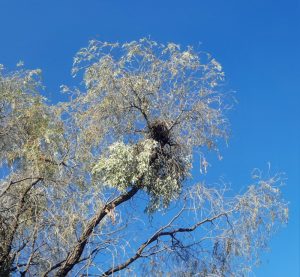
usual grey mistletoe found on myall trees
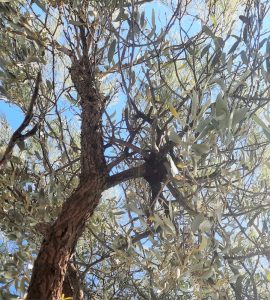
myall mistletoe (Amyema quandang)
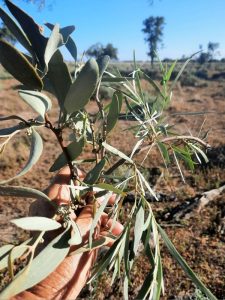
myall leaves with Amyema quandang leaves
And below is the only Myall tree Ive seen with Lysiana subfalcata growing on it. I know bugga all about mistletoe so it wasn’t the different variety that caught my eye but the way it is attached to the Myall tree. The junction between the tree & the mistletoe LOOKS LIKE A GRAFT !!! I think the gomilaroi people of this land have been moving mistletoe/ baan around different tree species for millennia. Not only because the flowers are sweet and the leaves medicinal but they attract birdlife to nest & feed as well as possums. ABORIGINAL PEOPLE WERE ACTIVE MANIPULATORS, NOT JUST PASSIVE BENEFICIARIES OF THEIR ENVIROMENTS
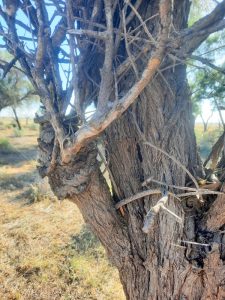
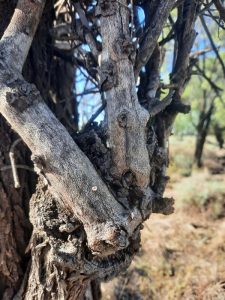
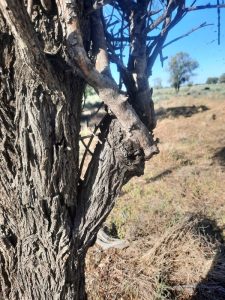
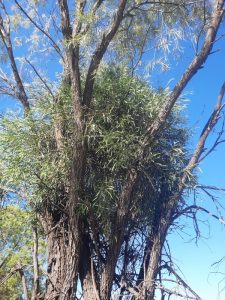
Now to the new (i.e new to me) sand slice on a neighbouring property. This triangular sand hill is a couple of ks away from the main paleo channel and not connected to it. I have been eyeing it off on Google earth for awhile & recently got permission to have a look around. There are a dozen TinTs Ive found so far on or near the sandslice. Below is a lovely low wilga TinT in the sand & nearby supplejack TinT on the edge of the red plains. Both hosts are bimble box – 1 large & the other relatively small but that could because of the different soil types they are growing in. Remember size doesn’t always match age on the sandhills of murra-manaarr!
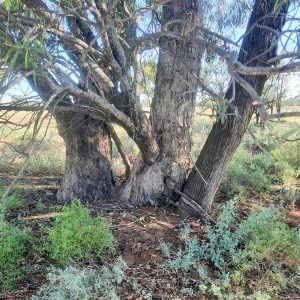
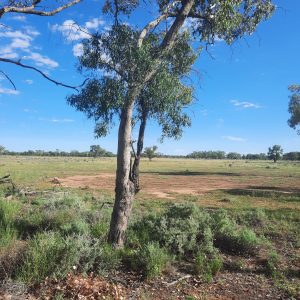
There is a low coolabah swamp to one side of the sandslice that has at least 4 ringtrees indicating a good water catchment.
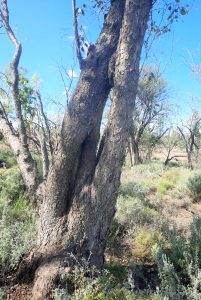
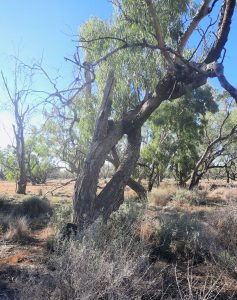
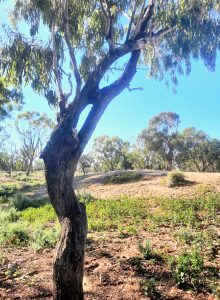
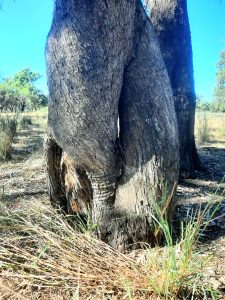
A tank/dam has been sunk on this natural water catch with a very high double TinT growing near the bank. The Currant bush & Thorny saltbush guests are situated high up in a box tree which has also survived a poisoning attempt. We don’t count saltbush as guest despite its longevity but in this case its difficult to see why only the currant bush gets ‘guest’ status.
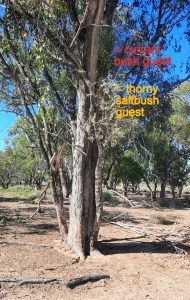
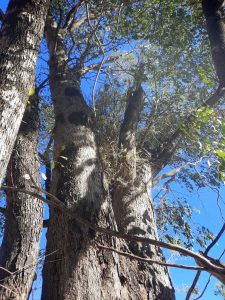
Lastly a couple of pics from a very old wailwun camp in the Ginghet Nature Reserve. There is a longstanding house tank/dam here & the 4 old wilga TinTs are within 100 metres from the water source & each other. I have used my elderly mother for perspective in this photo for both size & age. Im guessing these undeniably cultural TinT are at least twice as old as my mum? The box stump has not only been cut down with a stone axe but has been scorched around around one side as well. The other big wilga TinT guest is growing in a large split box that has been burnt on the inside only. Viewed on google earth these wailwun camps are found in the shallow box swamps along a very old water course. This tree line is the old river before the Ginghet which was the river that came before the Macquarie. The landscape has altered dramatically over the ages yet the wailwun people managed to adapt & thrive – quite astonishing really ….
